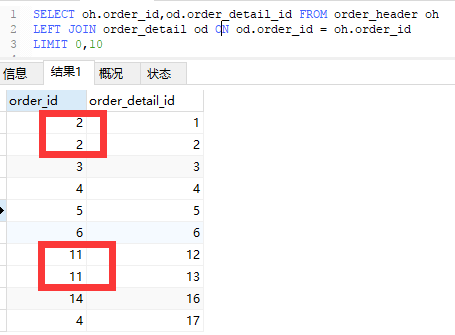mybatis 使用collection標籤實現一對多查詢(多分頁使用)
在使用**ListPage分頁工具類進行分頁操作時,如果使用一對多查詢,會造成查詢出來每一頁資料數量不等於實際規定的每一個數據數量。原因在於,一對多查詢的結果是包含了與子錶鏈接的資料,例如在查詢10個訂單(order_header)資料時,假如有兩個訂單均包含2條訂單條目(order_detail)資料,那麼最終查詢的10條資料只有8條order_header表的資料。
通常,我們為了解決這種問題,首先會先獲取到10條order_header資料,然後在遍歷訂單資料分別獲取每一條訂單資料的訂單條目資料,這樣會浪費資料庫的執行時間,下面使用collection進行查詢的方法,可以避開普通collection查詢造成的問題,也能達到其效果。
Mapper:
<?xml version="1.0" encoding="UTF-8"?> <!DOCTYPE mapper PUBLIC "-//mybatis.org//DTD Mapper 3.0//EN" "http://mybatis.org/dtd/mybatis-3-mapper.dtd"> <mapper namespace="OrderHeaderMapper"> <resultMap id="OrderView_M" type="OrderView_M"> <id column="order_id" property="orderID" jdbcType="INTEGER"/> <result column="order_number" property="orderNumber" jdbcType="VARCHAR"/> <result column="total_amount" property="totalAmount" jdbcType="DECIMAL"/> <result column="pay_status_id" property="payStatusID"/> <result column="order_status_id" property="orderStatusID"/> <collection property="orderDetail" column="order_id" ofType="OrderDetailView_M" javaType="ArrayList" select="getOrderDetailByOrderID"> </collection> </resultMap> <resultMap id="OrderDetailView_M" type="OrderDetailView_M"> <id column="order_detail_id" property="orderDetailID" jdbcType="INTEGER"/> <result column="product_name" property="productName" jdbcType="VARCHAR"/> <result column="photo_path" property="photoPath" jdbcType="VARCHAR"/> </resultMap> <!-- page為一個自定義分頁類,其中包括一個pd的map --> <select id="getOrderByCustomerListPage" parameterType="page" resultMap="OrderView_M"> SELECT oh.order_id, oh.order_number, oh.total_amount, oh.pay_status_id, oh.order_status_id FROM order_header oh WHERE oh.pay_status_id = #{pd.orderStatusID} ORDER BY oh.order_date DESC </select> <select id="getOrderDetailByOrderID" parameterType="java.lang.Integer" resultMap="OrderDetailView_M"> SELECT od.order_detail_id, od.product_name, od.photo_path, od.order_id FROM order_detail od LEFT JOIN product p ON p.product_id = od.product_id WHERE od.order_id = #{order_id} ORDER BY p.sku </select> </mapper>
public class OrderView_M { private Integer orderID; private String orderNumber; private BigDecimal totalAmount; private Integer payStatusID; private Integer orderStatusID; private List<OrderDetailView_M> orderDetail; public Integer getPayStatusID() { return payStatusID; } public Integer getOrderStatusID() { return orderStatusID; } public void setOrderStatusID(Integer orderStatusID) { this.orderStatusID = orderStatusID; } public void setPayStatusID(Integer payStatusID) { this.payStatusID = payStatusID; } public Integer getOrderID() { return orderID; } public void setOrderID(Integer orderID) { this.orderID = orderID; } public String getOrderNumber() { return orderNumber; } public void setOrderNumber(String orderNumber) { this.orderNumber = orderNumber; } public BigDecimal getTotalAmount() { return totalAmount; } public void setTotalAmount(BigDecimal totalAmount) { this.totalAmount = totalAmount; } public List<OrderDetailView_M> getOrderDetail() { return orderDetail; } public void setOrderDetail(List<OrderDetailView_M> orderDetail) { this.orderDetail = orderDetail; } }
public class OrderDetailView_M {
private Integer orderDetailID;
private String productName;
private String photoPath;
public String getProductName() {
return productName;
}
public void setProductName(String productName) {
this.productName = productName;
}
public String getPhotoPath() {
return photoPath;
}
public void setPhotoPath(String photoPath) {
this.photoPath = photoPath;
}
public Integer getOrderDetailID() {
return orderDetailID;
}
public void setOrderDetailID(Integer orderDetailID) {
this.orderDetailID = orderDetailID;
}
}相關推薦
mybatis 使用collection標籤實現一對多查詢(多分頁使用)
在使用**ListPage分頁工具類進行分頁操作時,如果使用一對多查詢,會造成查詢出來每一頁資料數量不等於實際規定的每一個數據數量。原因在於,一對多查詢的結果是包含了與子錶鏈接的資料,例如在查詢10個訂單(order_header)資料時,假如有兩個訂單均包含2條訂單條目(
MyBatis從入門到精通(十二):使用collection標籤實現巢狀查詢
最近在讀劉增輝老師所著的《MyBatis從入門到精通》一書,很有收穫,於是將自己學習的過程以部落格形式輸出,如有錯誤,歡迎指正,如幫助到你,不勝榮幸! 本篇部落格主要講解使用collection標籤實現巢狀查詢的方法。 1. 需求升級 在上篇部落格中,我們實現了需求:根據使用者id查詢使用者資訊的同時獲取使用
MVC+Bootstrap+Drapper使用PagedList.Mvc支持多查詢條件分頁
pagedlist amp new 源代碼 post header this 當前 都是 前幾天做一個小小小項目,使用了MVC+Bootstrap,以前做分頁都是異步加載Mvc部分視圖的方式,因為這個是小項目,就隨便一點。一般的列表頁面,少不了有查詢條件,下面分享下Drap
SpringBoot+Mybatis+ Druid+PageHelper 實現多數據源並分頁
utf 重置數據 count system 配置文件 urn 規模 pos mapper 前言 本篇文章主要講述的是SpringBoot整合Mybatis、Druid和PageHelper 並實現多數據源和分頁。其中SpringBoot整合Mybatis這塊,在之前的的一篇
springmvc配置myBatis,並實現增刪改查、分頁功能
springmvc配置myBatis myBatis是一個數據庫訪問的外掛,通過jdbc實現。 實現思路: 1.maven引入myBatis <!-- mybatis核心包 --> <dependenc
【筆記】Mybatis高階查詢(四)--使用resultMap的<collection>標籤實現一對多和多對多查詢
<collection>集合的巢狀結果對映就是指通過一次SQL查詢將所有的結果查詢出來,然後對映到不同的物件中。在一對多的關係中,主表一條資料會對應關聯表的多條資料。因此一般查詢時會查詢出多條結果,按照一對多的資料對映時,最終的結果數會小於等於查詢的總記錄數。
mybatis xml中實現一對多查詢時, 子查詢帶多個引數
1、mapper檔案中: List<Object> getXXXXX(@Param("taskId")String taskId,@Param("taskType")String taskType); 2、xml檔案中 <select id="" resultMap
mybatis使用resultMap實現一對多查詢 (需求:查詢訂單以及訂單明細)
使用resultMap將查詢出的訂單明細資訊對映Order,java的屬性中 在Orders.java建立訂單明細屬性(一個集合物件,一訂單對應多個訂單明細) public class Orders { private int id;//訂單號 private in
PHP連接數據庫實現多條件查詢與分頁功能——關於租房頁面的完整實例操作
ots cnblogs 信息 val 租房 btn earch 拼接 round 租房頁面如圖: 代碼如下: <!DOCTYPE html><html> <head> <meta charset="UTF-8"
Spring Data JPA 二:實現多表關聯分頁查詢
最近在對JPA的使用過程中發現對於單表的操作很是方便,但是當設計到多表聯查的時候就需要有一些特殊的操作了。 專案中有一個場景是後臺需要做一個分頁的列表查詢,所需要的資料分散在兩張表中,如果是用mybatis的話直接定義resultMap,然後手寫SQL就可以了。而在JPA中就需要用到JPQL
【筆記】Mybatis高階查詢(三)--使用<association>標籤實現巢狀查詢及延遲載入
<association>標籤實現巢狀查詢,需要用到以下屬性: select:另一個對映查詢的ID,Mybatis會額外執行這個查詢獲取巢狀物件的結果。 column:列名或別名,將主查詢中列的結果作為巢狀查詢的引數,配置方式如column=
MyBatis-Plus多表聯合查詢並且分頁(3表)
這3張表的關係是 模型表Model ===> 訓練表Training ===》應用表Application(大概的邏輯是:選擇應用,然後訓練,然後成為模型)如有不理解的可加我微信:17625089935 白天問我一般晚上回 首先我們先建立實體Model(我使用的d
(六)springboot + mybatis plus實現多表聯查分頁3.X版本
註明 : 上兩篇文章我們講解了springboot+mybatis-plus對於單表的CRUD和條件構造器的使用方法,但是對於我們的實戰專案中多表聯查也是經常會出現的。今天我們就來說下怎麼在springboot+MP模式下實現多表聯查並分頁。 MP推薦使用的是
SpringData jpa 實現多條件動態查詢,分頁功能
問題由來: 剛開始使用springdata的時候,只會用findByName這樣的簡單查詢,這樣寫dao層確實非常的快,但是在我們做篩選功能的時候,這樣的查詢似乎很難滿足我們的需求,但是都已經用上的springdata又不想再去寫mybatis這樣在xml裡面判
SpringBoot+Mybatis+ Druid+PageHelper 實現多資料來源並分頁
前言 本篇文章主要講述的是SpringBoot整合Mybatis、Druid和PageHelper 並實現多資料來源和分頁。其中SpringBoot整合Mybatis這塊,在之前的的一篇文章中已經講述了,這裡就不過多說明了。重點是講述在多資料來源下的如何配置使用Druid和PageHelper 。 Druid
Entity Framework4.1實現動態多條件查詢、分頁和排序
EF通用的分頁實現: 1 2 3 4 5 6 7 8 9 10 11 12 13 14 15 16 17 18 19 2
springboot + mybatis plus實現多表聯查分頁
auto score ice get pro err type 實現 app 1 配置分頁插件 public class MybatisPlusConfig { @Bean public PaginationInterceptor paginationInt
MyBatis從入門到精通(十):使用association標籤實現巢狀查詢
最近在讀劉增輝老師所著的《MyBatis從入門到精通》一書,很有收穫,於是將自己學習的過程以部落格形式輸出,如有錯誤,歡迎指正,如幫助到你,不勝榮幸! 本篇部落格主要講解使用association標籤實現巢狀查詢的方法。 1. 明確需求 仍然延用上篇部落格中的需求:根據使用者id查詢使用者資訊的同時獲取該使用
HBase多條件及分頁查詢的一些方法
nosql數據庫 應用場景 實現簡單 信息 byte 多條 多個 不可用 寫性能 HBase是Apache Hadoop生態系統中的重要一員,它的海量數據存儲能力,超高的數據讀寫性能,以及優秀的可擴展性使之成為最受歡迎的NoSQL數據庫之一。它超強的插入和讀取性能與它的數據
MyBatis學習總結——實現關聯表查詢(轉)
得到 into primary 字符串 student prim oci ssr ret 原文鏈接:孤傲蒼狼 一、一對一關聯 1.1、提出需求 根據班級id查詢班級信息(帶老師的信息) 1.2、創建表和數據 創建一張教師表和班級表,這裏我們假設一個老師只負責教一個

